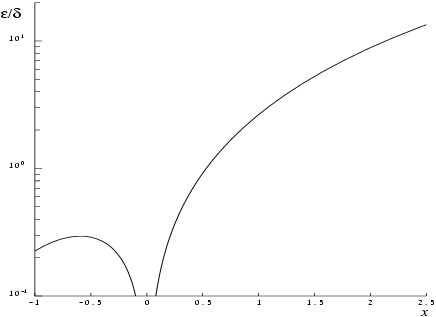NAG Library Routine Document
s15adf (erfc_real)
1
Purpose
s15adf returns the value of the complementary error function, , via the function name.
2
Specification
Fortran Interface
| Real (Kind=nag_wp) | :: | s15adf | | Integer, Intent (Inout) | :: | ifail | | Real (Kind=nag_wp), Intent (In) | :: | x |
|
C Header Interface
|
#include nagmk26.h
| double |
s15adf_ (const double *x, Integer *ifail) |
|
3
Description
s15adf calculates an approximate value for the complement of the error function
Let
be the root of the equation
(then
). For
the value of
is based on the following rational Chebyshev expansion for
:
where
denotes a rational function of degree
in the numerator and
in the denominator.
For
the value of
is based on a rational Chebyshev expansion for
: for
the value is based on the expansion
and for
it is based on the expansion
For each expansion, the specific values of
and
are selected to be minimal such that the maximum relative error in the expansion is of the order
, where
is the maximum number of decimal digits that can be accurately represented for the particular implementation (see
x02bef).
For
there is a danger of setting underflow in
(the value of
is given in the
Users' Note for your implementation). For
,
s15adf returns
; for
it returns
.
4
References
Abramowitz M and Stegun I A (1972) Handbook of Mathematical Functions (3rd Edition) Dover Publications
Cody W J (1969) Rational Chebyshev approximations for the error function Math.Comp. 23 631–637
5
Arguments
- 1: – Real (Kind=nag_wp)Input
-
On entry: the argument of the function.
- 2: – IntegerInput/Output
-
On entry:
ifail must be set to
,
. If you are unfamiliar with this argument you should refer to
Section 3.4 in How to Use the NAG Library and its Documentation for details.
For environments where it might be inappropriate to halt program execution when an error is detected, the value
is recommended. If the output of error messages is undesirable, then the value
is recommended. Otherwise, if you are not familiar with this argument, the recommended value is
.
When the value is used it is essential to test the value of ifail on exit.
On exit:
unless the routine detects an error or a warning has been flagged (see
Section 6).
6
Error Indicators and Warnings
There are no failure exits from
s15adf. The argument
ifail has been included for consistency with other routines in this chapter.
7
Accuracy
If
and
are relative errors in the argument and result, respectively, then in principle
That is, the relative error in the argument,
, is amplified by a factor
in the result.
The behaviour of this factor is shown in
Figure 1.
It should be noted that near
this factor behaves as
and hence the accuracy is largely determined by the
machine precision. Also for large negative
, where the factor is
, accuracy is mainly limited by
machine precision. However, for large positive
, the factor becomes
and to an extent relative accuracy is necessarily lost. The absolute accuracy
is given by
so absolute accuracy is guaranteed for all
.
8
Parallelism and Performance
s15adf is not threaded in any implementation.
None.
10
Example
This example reads values of the argument from a file, evaluates the function at each value of and prints the results.
10.1
Program Text
Program Text (s15adfe.f90)
10.2
Program Data
Program Data (s15adfe.d)
10.3
Program Results
Program Results (s15adfe.r)

